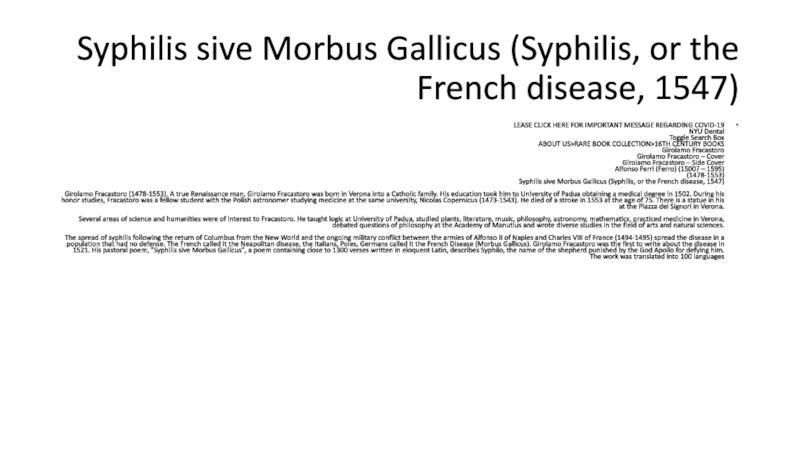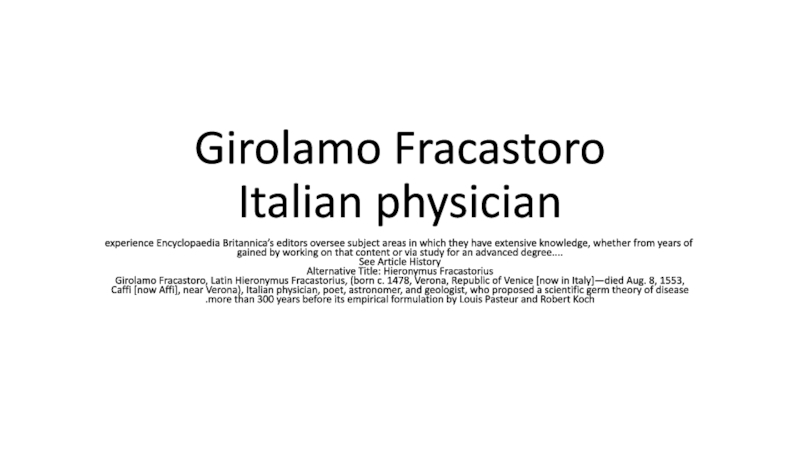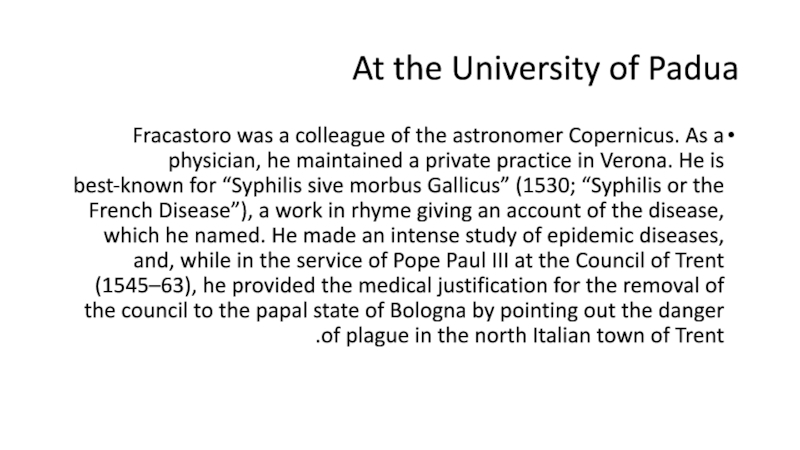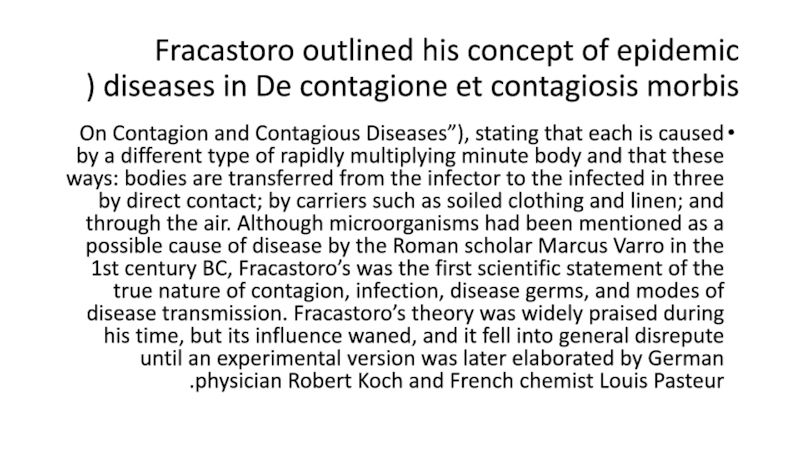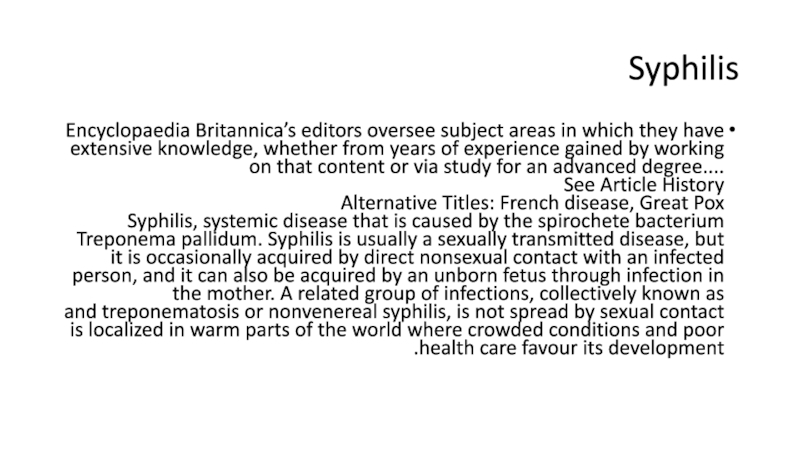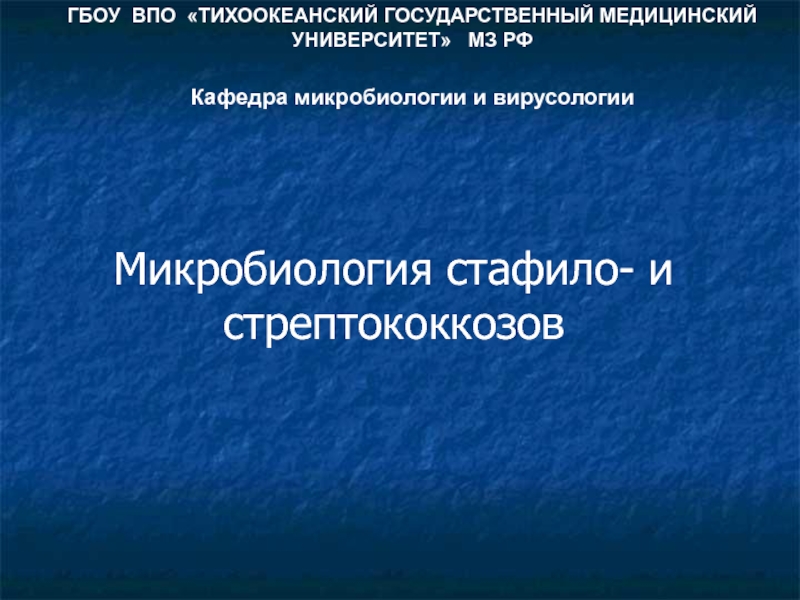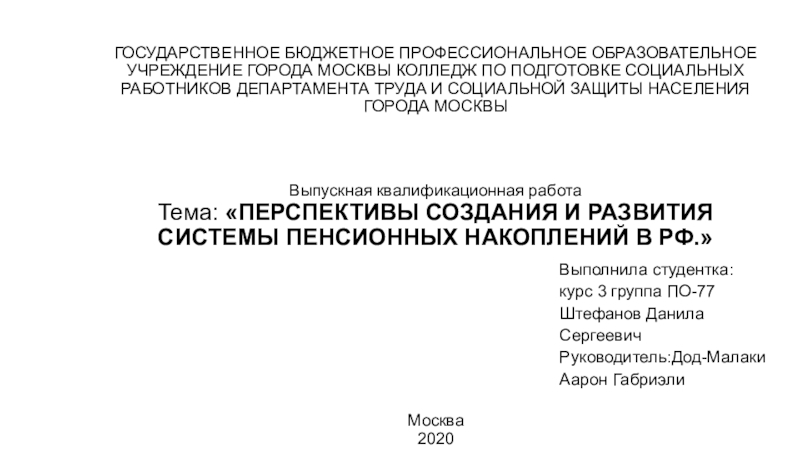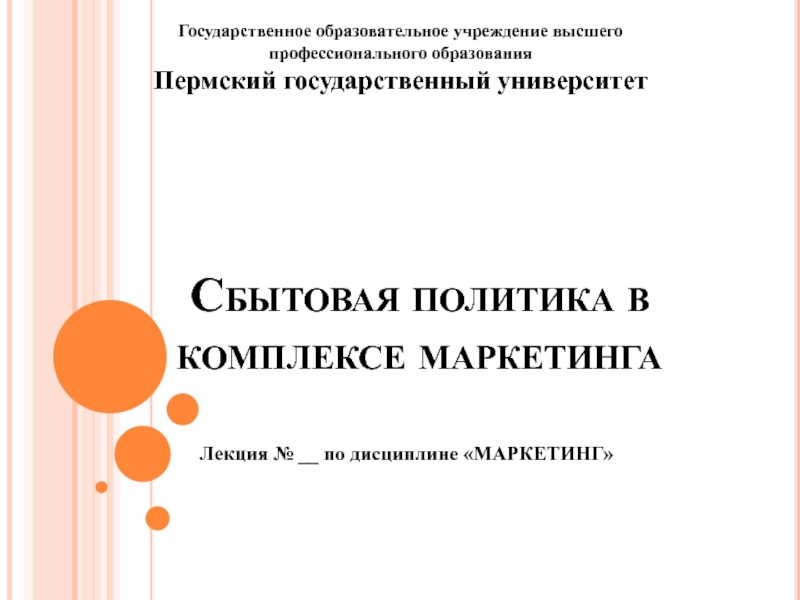Слайд 1Girolamo Fracastoro
Italian physician
Encyclopaedia Britannica’s editors oversee subject areas in which
they have extensive knowledge, whether from years of experience gained
by working on that content or via study for an advanced degree....
See Article History
Alternative Title: Hieronymus Fracastorius
Girolamo Fracastoro, Latin Hieronymus Fracastorius, (born c. 1478, Verona, Republic of Venice [now in Italy]—died Aug. 8, 1553, Caffi [now Affi], near Verona), Italian physician, poet, astronomer, and geologist, who proposed a scientific germ theory of disease more than 300 years before its empirical formulation by Louis Pasteur and Robert Koch.
Слайд 2At the University of Padua
Fracastoro was a colleague of the
astronomer Copernicus. As a physician, he maintained a private practice
in Verona. He is best-known for “Syphilis sive morbus Gallicus” (1530; “Syphilis or the French Disease”), a work in rhyme giving an account of the disease, which he named. He made an intense study of epidemic diseases, and, while in the service of Pope Paul III at the Council of Trent (1545–63), he provided the medical justification for the removal of the council to the papal state of Bologna by pointing out the danger of plague in the north Italian town of Trent.
Слайд 3Fracastoro outlined his concept of epidemic diseases in De contagione
et contagiosis morbis (
On Contagion and Contagious Diseases”), stating that
each is caused by a different type of rapidly multiplying minute body and that these bodies are transferred from the infector to the infected in three ways: by direct contact; by carriers such as soiled clothing and linen; and through the air. Although microorganisms had been mentioned as a possible cause of disease by the Roman scholar Marcus Varro in the 1st century BC, Fracastoro’s was the first scientific statement of the true nature of contagion, infection, disease germs, and modes of disease transmission. Fracastoro’s theory was widely praised during his time, but its influence waned, and it fell into general disrepute until an experimental version was later elaborated by German physician Robert Koch and French chemist Louis Pasteur.
Слайд 4Syphilis
Encyclopaedia Britannica’s editors oversee subject areas in which they have
extensive knowledge, whether from years of experience gained by working
on that content or via study for an advanced degree....
See Article History
Alternative Titles: French disease, Great Pox
Syphilis, systemic disease that is caused by the spirochete bacterium Treponema pallidum. Syphilis is usually a sexually transmitted disease, but it is occasionally acquired by direct nonsexual contact with an infected person, and it can also be acquired by an unborn fetus through infection in the mother. A related group of infections, collectively known as treponematosis or nonvenereal syphilis, is not spread by sexual contact and is localized in warm parts of the world where crowded conditions and poor health care favour its development.
Слайд 5Syphilis Through History
The causative organism of venereal syphilis is a
slender, coiled, flexible bacterium with regular, tightly wound coils. This
bacterium, T. Pallidum, averages 8 to 10 microns (millionths of a metre) in length. The bacterium requires moisture to exist, so continuous moisture is a necessity for the transfer of the microorganism from one person to another. The most common means of such transferal is sexual intercourse. In the body’s tissues, the spirochete bacteria reproduce and remain present for the lifetime of the infected person unless destroyed by treatment. Syphilis is effectively treated with penicillin, which kills the spirochetes.
Scanning electron micrograph of Treponema pallidum, the spirochete bacterium that is the causative agent of syphilis.The historical origin of venereal syphilis is obscure. Indisputable reference to it in European literature occurred only after the return of Columbus from the New World. The rapidly spreading scourge was given several names, including “Great Pox” and “French disease,” the latter after invading French soldiers either brought the infection to Italy or caught it from the Italians. The modern name was coined in 1530 by the Italian physician and writer Girolamo Fracastoro, who made poetic reference to a mythic Greek shepherd, Syphilus, who was cursed by the god Apollo with a dread disease. The theory of a New World origin has been supported by evidence of treponematosis found in the skeletal remains of pre-Columbian American Indians. On the other hand, “leprosy” in Europe before 1500 was considered highly contagious, was associated with sexual contact, had hereditary features, and was said to respond to mercury therapy; therefore, it is possible that many cases thought to be leprosy were actually syphilis.
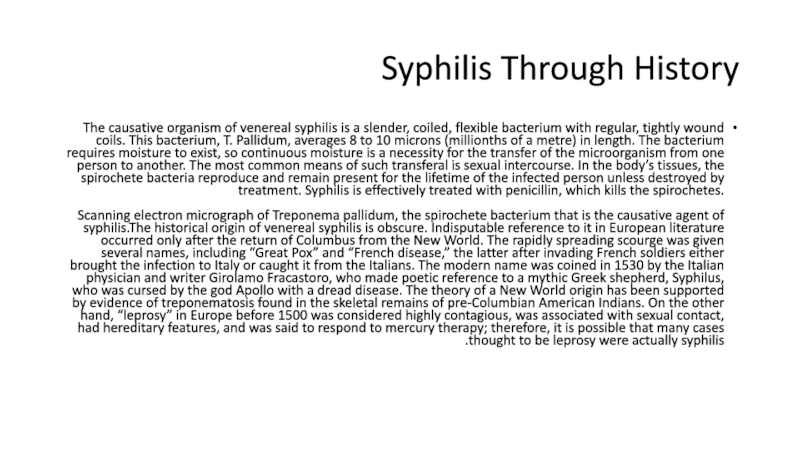
Слайд 6Fracastoro was born in Verona
Fracastoro was born in Verona, Republic
of Venice and educated at Padua where at 19 he
was appointed professor at the University. On account of his eminence in the practice of medicine, he was elected physician of the Council of Trent. A bronze statue was erected in his honor by the citizens of Padua, while his native city commemorated their great compatriot by a marble statue. He lived and practised in his hometown. In 1546 he proposed that epidemic diseases are caused by transferable tiny particles or "spores" that could transmit infection by direct or indirect contact or even without contact over long distances.[3] In his writing, the "spores" of diseases may refer to chemicals rather than to any living entities.
He appears to have first used the Latin word fomes, meaning tinder, in the sense of infectious agent, in his essay on contagion De Contagione et Contagiosis Morbis, published in 1546:[4] "I call fomites [from the Latin fomes, meaning "tinder"] such things as clothes, linen, etc., which although not themselves corrupt, can nevertheless foster the essential seeds of the contagion and thus cause infection.".[5] His theory remained influential for nearly three centuries, before being superseded by a fully developed germ theory.
The name for syphilis is derived from Fracastoro’s 1530 epic poem in three books, Syphilis sive morbus gallicus ("Syphilis or The French Disease"), about a shepherd boy named Syphilus who insulted the Greek god Apollo[6] and was punished by that god with a horrible disease. The poem suggests using mercury and "guaiaco" as a cure. His 1546 book (De contagione, "On Contagion") also gave the first description for typhus. The collected wo ph.[9]
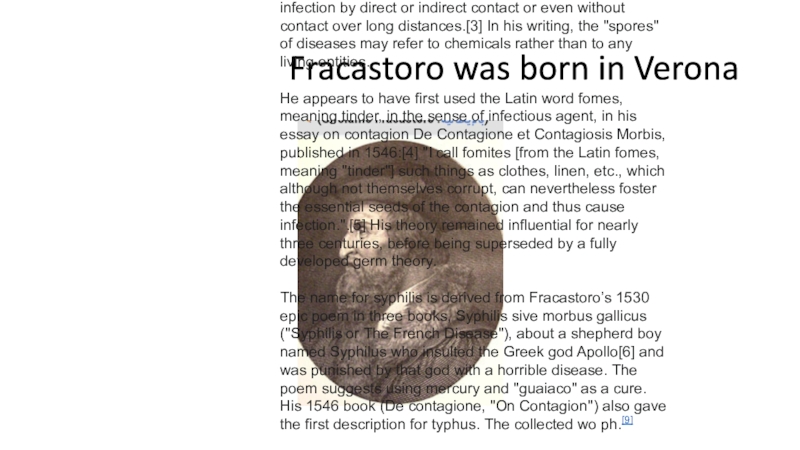
Слайд 7SYPHILIS
THE "SYPHILIS" OF GIROLAMO FRACASTORO: With Some Observations on the
Origin and History of the Word "Syphilis"
G. L. HENDRICKSONOne of
the largest publishers in the United States, the Johns Hopkins University Press combines traditional books and journals publishing units with cutting-edge service divisions that sustain diversity and independence among nonprofit, scholarly publishers, societies, and associations. Journals The Press is home to the largest journal publication program of any U.S.-based university press. The Journals Division publishes 85 journals in the arts and humanities, technology and medicine, higher education, history, political science, and library science. The division also manages membership services for more than 50 scholarly and professional associations and societies. Books With critically acclaimed titles in history, science, higher education, consumer health, humanities, classics, and public health, the Books Division publishes 150 new books each year and maintains a backlist in excess of 3,000 titles. With warehouses on three continents, worldwide sales representation, and a robust digital publishing program, the Books Division connects Hopkins authors to scholars, experts, and educational and research institutions around the world. Project MUSE® Project MUSE is a leading provider
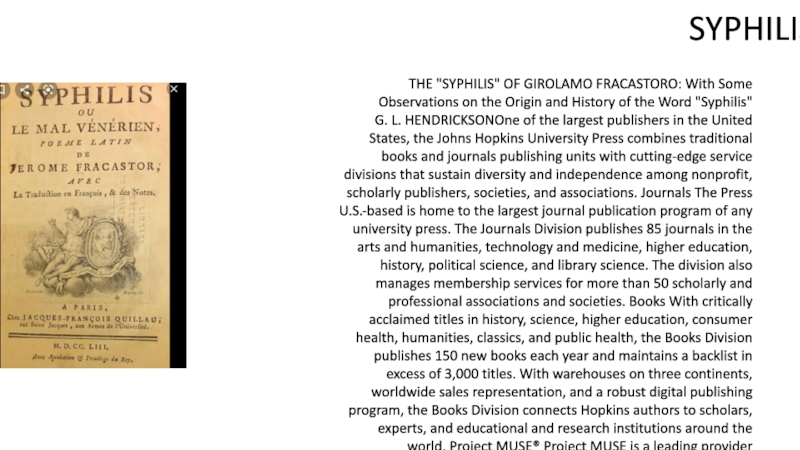
Слайд 8Syphilis sive Morbus Gallicus (Syphilis, or the French disease, 1547)
LEASE
CLICK HERE FOR IMPORTANT MESSAGE REGARDING COVID-19
NYU Dental
Toggle Search Box
ABOUT
US>RARE BOOK COLLECTION>16TH CENTURY BOOKS
Girolamo Fracastoro
Girolamo Fracastoro – Cover
Girolamo Fracastoro – Side Cover
Alfonso Ferri (Ferro) (1500? – 1595)
(1478-1553)
Syphilis sive Morbus Gallicus (Syphilis, or the French disease, 1547)
Girolamo Fracastoro (1478-1553). A true Renaissance man, Girolamo Fracastoro was born in Verona into a Catholic family. His education took him to University of Padua obtaining a medical degree in 1502. During his studies, Fracastoro was a fellow student with the Polish astronomer studying medicine at the same university, Nicolas Copernicus (1473-1543). He died of a stroke in 1553 at the age of 75. There is a statue in his honor at the Piazza dei Signori in Verona.
Several areas of science and humanities were of interest to Fracastoro. He taught logic at University of Padua, studied plants, literature, music, philosophy, astronomy, mathematics, practiced medicine in Verona, debated questions of philosophy at the Academy of Manutius and wrote diverse studies in the field of arts and natural sciences.
The spread of syphilis following the return of Columbus from the New World and the ongoing military conflict between the armies of Alfonso II of Naples and Charles VIII of France (1494-1495) spread the disease in a population that had no defense. The French called it the Neapolitan disease, the Italians, Poles, Germans called it the French Disease (Morbus Gallicus). Girolamo Fracastoro was the first to write about the disease in 1521. His pastoral poem, "Syphilis sive Morbus Gallicus", a poem containing close to 1300 verses written in eloquent Latin, describes Syphilo, the name of the shepherd punished by the God Apollo for defying him. The work was translated into 100 languages
